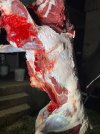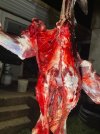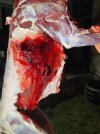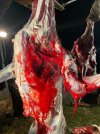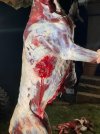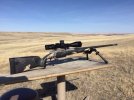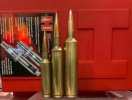Shot 2 deer on Saturday with the 7 Allen and the 150 BD-2's. Both were almost broadside. First doe was at 300 yd. Lung shot. Two petals came out the front of the deer through the brisket. (90 deg from shot angle) Part of it seemed to bust straight through - likely the shank. Lungs were gone, and front of stomach tore open. Deer was a total mess. Impact side shoulder was basically detached even though bullet hit well back from it. Impact velocity should have been around 3,200. Second big doe was at 400 yd, impact velocity around 3030. This one I tried for bone. Impact rear shoulder and low lung and heart. Heart was half gone. Lungs and liver lacerated, and again the near shoulder was dislocated and a total mess. No frags found. My internet slowed down too much to post pics right now as I'm over data for the month, but I'll try to remember to get you some later.
Not sure what was going on, but it's too much damage for me. Seems they open so fast on impact that the initial splash-back convulses the near side so bad it just kind of blew the shoulder attachments apart. Exit side was less damaged on both deer though the 300 yd doe had a lot of bloodshot on exit side. Both were running from hunting pressure though standing when shot, but high on adrenaline. Both really convulsed at impact and ran about 30 - 50 yd after impact, but a lot less enthusiastically than I've normally observed. Obviously hurt bad. The one at 400 yd was at dusk and I could easily see a cloud of steam shoot out the impact side and a little out the exit side. Not sure what to think. Either bad batch of copper, or the tipped design just can't handle those velocities. Have you seen a Hammer do that yet? I will need to try the same impact speed to evaluate, but from observing others results it seems maybe the non-tipped design or the hardness difference (if any) prevents this kind of violent disintegration. I don't know. Hard to get the best of all worlds in one product. Badlands warned me that he didn't think their bullet would hold together at my velocities. I'm sure under "normal" impact speeds, they would be phenomenal, and it's possible the tip would give an advantage on the bottom velocity end of the spectrum. Just hypothesizing. Wish I had the chance to take one at 800 yd or beyond to see what happens. 20+ mph winds didn't make that "ethical" for me. I'll try to post pics in a few days when internet speeds get restored.
Not sure what was going on, but it's too much damage for me. Seems they open so fast on impact that the initial splash-back convulses the near side so bad it just kind of blew the shoulder attachments apart. Exit side was less damaged on both deer though the 300 yd doe had a lot of bloodshot on exit side. Both were running from hunting pressure though standing when shot, but high on adrenaline. Both really convulsed at impact and ran about 30 - 50 yd after impact, but a lot less enthusiastically than I've normally observed. Obviously hurt bad. The one at 400 yd was at dusk and I could easily see a cloud of steam shoot out the impact side and a little out the exit side. Not sure what to think. Either bad batch of copper, or the tipped design just can't handle those velocities. Have you seen a Hammer do that yet? I will need to try the same impact speed to evaluate, but from observing others results it seems maybe the non-tipped design or the hardness difference (if any) prevents this kind of violent disintegration. I don't know. Hard to get the best of all worlds in one product. Badlands warned me that he didn't think their bullet would hold together at my velocities. I'm sure under "normal" impact speeds, they would be phenomenal, and it's possible the tip would give an advantage on the bottom velocity end of the spectrum. Just hypothesizing. Wish I had the chance to take one at 800 yd or beyond to see what happens. 20+ mph winds didn't make that "ethical" for me. I'll try to post pics in a few days when internet speeds get restored.
Last edited:

